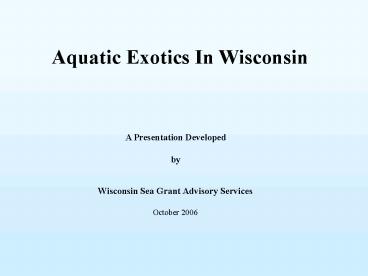Aquatic Exotics In Wisconsin - PowerPoint PPT Presentation
1 / 29
Title:
Aquatic Exotics In Wisconsin
Description:
Carp in 1880's. Aquatic Exotics In Wisconsin. Some escaped from lakes, ponds or as bait: ... Grass Carp. Rusty Crayfish. Purple Loosestrife. Aquatic Exotics In ... – PowerPoint PPT presentation
Number of Views:53
Avg rating:3.0/5.0
Title: Aquatic Exotics In Wisconsin
1
Aquatic Exotics In Wisconsin
A Presentation Developed by
Wisconsin Sea Grant Advisory Services October
2006
2
Aquatic Exotics In Wisconsin
- Wisconsin has become host to several aquatic
species that never existed here naturally - Some Atlantic Ocean species came in through the
Welland Canal - Lampreys, 1930s
- Alewife, 1949
- White perch, 1989
- Three-spine stickleback 1991
3
Aquatic Exotics In Wisconsin
- Some were intentionally introduced
- Chinook and Coho salmon 1963
- Rainbow trout 1963
- Brown trout 1960s
- Carp in 1880s
4
Aquatic Exotics In Wisconsin
- Some escaped from lakes, ponds or as bait
- Smelt
- Goldfish
- Grass Carp
- Rusty Crayfish
- Purple Loosestrife
5
Aquatic Exotics In Wisconsin
- Some recent invaders came in the ballast water of
sea-going ships - Ruffe in 1986
- Zebra Mussels in 1988
- Spiny water flea in 1990
- Round goby in 1995
6
Aquatic Exotics In Wisconsin
- Invasive species traits
- High reproductive rate
- Mature quickly
- Eat various types of food
- Tolerate poor water quality
- Easily adapt to new habitats
7
Aquatic Exotics In Wisconsin
- Native species traits
- Have narrow food preferences
- Require certain spawning habitat
- Intolerant of poor water quality
8
Aquatic Exotics In Wisconsin
- A Quick look at six recent invaders
- Zebra mussels
- Round goby
- Ruffe
- Purple loosestrife
- Eurasian milfoil
- Spiny water fleas
9
Zebra Mussel
Max. size 2
Introduced via ballast water from Europe
First found in Lake St. Claire (MI) in 1988
Eats plankton, filters up to 1 liter of water
per day
Produce 40,000 eggs/year
Densities up to 700,000 per sq. meter
43,000 on a piece of notebook paper
Spread easily via planktonic larvae and adults
stuck on weeds and boats
10
Zebra Mussel Life Cycle
Planktonic up to 1 month
Settle and attach to substrate
Wisconsin Sea Grant Advisory Services
11
Zebra Mussels Colonize Lots of Things
12
Zebra mussels get moved to new lakes by water in
and weeds on boats.
13
Zebra Mussels 2008
(26 counties, 101 lakes)
14
Wisconsin Lakes With Zebra Mussels
82
Why the big jump in 2006?
Better monitoring and additional infestations
15
Ruffe
3-4 Long
Max. 10
S. Zienert
First found in 1986 in Lake Superior
Introduced via ballast water from Southern Europe
Affects perch, whitefish and minnows
Eats fish eggs, bottom-dwelling insects and worms
Now Present in Lakes Superior, Huron and Michigan
16
Round Goby
3-4 Long
Max. 10
Introduced via ballast water from Europe
Affects sculpins and other bottom-dwelling species
Eats fish eggs, bottom-dwelling insects and worms
Present in all the Great Lakes, Chicago River
17
- Purple Loosestrife
4-Sided Stem
2 Million Seeds per Year
Displaces Native Vegetation
Destroys Habitat
- Controlled by
Physical Removal
Beetles
18
Galerucella beetles biocontrol for purple
loosestrife
19
Purple Loosestrife
20
- Eurasian Watermilfoil
- - Displaces native vegetation- Clogs boating and
swimming areas- Spread by boaters through
fragmentation - ControlNorthern milfoil beetleChemical
21
Eurasian milfoil compared to Northern milfoil
22
Eurasian Milfoil
Present in62 counties gt 475 waters
23
Rusty Crayfish
- Native to southern U.S.
- Introduced with bait
- Aggressive
- Destroys vegetation as they feed
- Displaces native crayfish
- Present in many Wisconsin lakes
- Often spread as bait
24
Rusty Crayfish
Documented
Suspected
25
Spiny Water Flea - BC CP
Bythotrephes cederstroemi Cercopagis pengoi
5mm Long
Max. 1/3
Long spines make them hard for fish to eat
Foul fishing lines and nets (look fuzzy or gooey)
Introduced via ballast water from Europe
Present in all the Great Lakes and Gile Flowage
in WI
26
Preventing The Spread
Drain bilge water
Dispose of live bait
Clean off weeds
27
If You Catch An Aquatic Exotic
KEEP It
Put it in a plastic bag or foil
FREEZE It
Put it in a freezer or ice chest
REPORT It
28
Aquatic Exotics In Wisconsin
- How Can You Help?
- Learn To Identify Them
- Report If You Catch One
- Know Their Effects on the Ecosystem
- Prevent Their Spread
- Teach Others
29
For More Information
- Visit the Sea Grant Nonindigenous Species Sites
- www.sgnis.org
- www.seagrant.wisc.edu
- Or Call
- Wisconsin Sea Grant
- (920) 683-4697
- Wisconsin Department of Natural Resources
- (608) 266-9270































